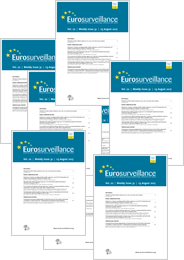- Home
- Weekly releases (1997–2007)
- Previous Issues
- Volume 5, Issue 44, 01/Nov/2001
Weekly releases (1997–2007) - Volume 5, Issue 44, 01 November 2001
Volume 5, Issue 44, 2001
- Articles
-
-
-
Interim European surveillance case definition for anthrax
More LessThe heads of national surveillance and public health centres, at a meeting in Luxembourg on 30 October 2001, agreed an interim surveillance case definition for anthrax for Europe (box). While anthrax is not formally notifiable internationally at the present time (click here), it was agreed that ascertainment of a single case of confirmed or probable human anthrax should be the subject of an “early warning” within the European Union under the provision of Decision no. 2119/98/EC of 24 September 1998 (Network Decision).
-
-
-
Anthrax in the United States – summary of cases confirmed by CDC
More LessOn the basis of a rigorous case definition (http://www.cdc.gov/mmwr/preview/mmwrhtml/mm5041a1.htm), the Centers for Disease Control and Prevention (CDC) in Atlanta has reported 16 confirmed cases of anthrax: two in Florida, four in New York City, five in New Jersey, and five in Washington DC. CDC is also reporting four suspect cases: three in New York City and one in New Jersey. The table below summarises the numbers of cases reported by 30 October 2001 (6pm ET).
-
-
-
Flu season in Europe starts off at very low levels
More LessInfluenza activity in Europe is very low, according to the first weekly electronic bulletin of the 2001-02 influenza season from the European Influenza Surveillance Scheme (EISS) (1). Eight networks reported clinical influenza activity to EISS in week 42/2001 (15-21 October 2001). Seven networks reported no influenza activity (Belgium, Denmark, England, Germany, Ireland, Italy, and Switzerland), and a local outbreak of influenza was reported in Wales. The intensity of activity in all networks was low.
-
-
-
Severe invasive group A streptococcal disease, Norway, 2000
More LessThe modernised national notification system for infectious diseases in Norway (Meldingssystem for smittsomme sykdommer, MSIS) was implemented on a national level in 1975. Cases of systemic group A streptococcal (GAS) disease (diagnosed by blood culture or cerebrospinal fluid (CSF) positives, or both) have been notifiable since the beginning. With the introduction of the Infectious Diseases Control Act in 1995, severe invasive GAS disease (including necrotising fasciitis) with or without a positive blood culture was included in the MSIS database.
-
-
-
Adverse effects of antiretroviral treatment for HIV infection
More LessTreatment of HIV-1 infection is known to have adverse effects, but there are few studies of how many people having treatment are affected by adverse reactions, especially studies of ordinary clinical practise and not clinical trial situations. The authors of a study conducted in Switzerland among 1160 people receiving antiretroviral treatment, which was published in the Lancet, report a high prevalence of toxic effects attributed to antiretroviral treatment for HIV-1 (1).
-
-
Most Read This Month

-
-
Chikungunya in north-eastern Italy: a summing up of the outbreak
R Angelini , A C Finarelli , P Angelini , C Po , K Petropulacos , G Silvi , P Macini , C Fortuna , G Venturi , F Magurano , C Fiorentini , A Marchi , E Benedetti , P Bucci , S Boros , R Romi , G Majori , M G Ciufolini , L Nicoletti , G Rezza and A Cassone
-
- More Less


